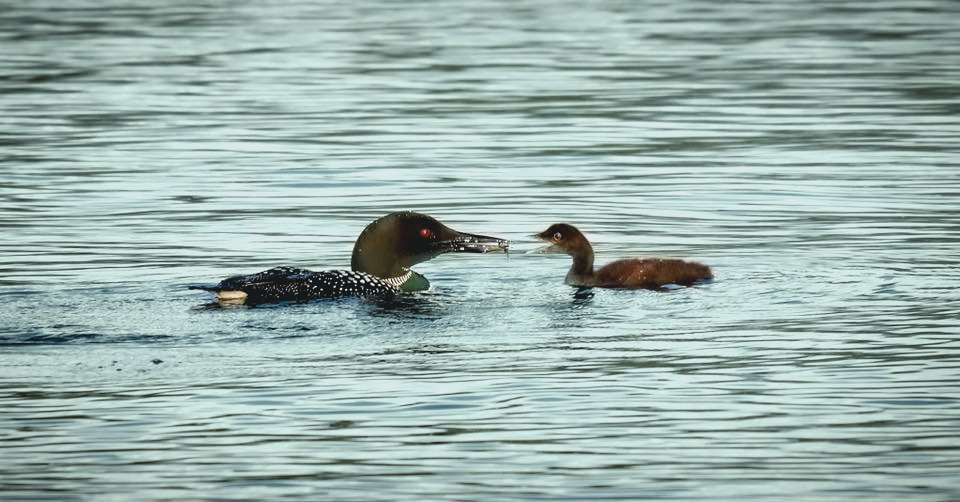Loon Monitoring Report
LOONWATCH ANNUAL LAKES MONITORING PROGRAM
LONG LAKE - BURNETT COUNTY
Loon Etiquett
The Long lake Association has been supporting the Loon population on our lake from the start. Each spring after the ice out, three Loon Nesting Platforms are placed, one in each section of the lake to help our Loons with the nesting process. Our members take great joy in watching the baby chicks hatch and grow through the summer. We are part of the Loon Watch Program.
Please help us protect our Loons by:
- Not using lead fishing tackle, loons sometimes swallow stray fishing tackle and suffer the effects of lead poisoning.
- Being respectful of nesting loons and giving them time and space. View loons with binoculars while maintaining a safe distance. Use the 200 ft rule when observing, especially around the nests.
- Maintain a “no wake” near the loon nests, a wake can flood and destroy loon nests. Slow down! Especially during nesting season, boat wakes and waves can wash out nests. Also be mindful after chicks have hatched. They cannot escape a fast moving boat by diving.
- Participate in the WI DNR’s monofilament recycling program. Never fish near loons, and clean up monofilament line so loons and other wildlife do not become entangled.
- A fed loon is a dead loon. NEVER feed loons, as they will associate humans with food and inevitably become tangled in fishing line and lead poisoned. Loons are excellent predators, and do not need help finding food.
- When kayaking or canoeing, give nesting loons a wide berth (200 ft. rule). If a loon is startled off its nest, it will not return until it feels safe.

* Floaters are visitors to lake, generally seen early morning in a group setting.
Loon Watch on Long Lake
Year
2025
2024
2023
2022
2021
2020
2019
2018
2017
2016
2015
2014
2013
2012
2011
2010
2009
2008
2007
2006
2005
2004
2003
2002
Nesting Pairs
3
3
3
x
x
2
3
3
3
3
3
3
3
x
x
3
3
x
2
2
1
2
2
1
Hatched Chicks
1
1
x
x
2
5
3
3
6
4
3
2
x
x
3
3
x
2
2
2
1
2
2
Chicks 8 Weeks Old
0
0
x
x
1
4
2
3
6
4
1
2
x
x
3
3
x
2
1
2
1
2
1
Loon Observation
The territorial pair seems to have split up. What happened?
- It is likely that one loon is on the nest while the other is on the lake fishing, preening and looking out for intruders.
Where are they nesting?
- If you cannot find the nest, watch the loon in its territory. The loon pair will switch “duties”, and the loon on the lake will swim toward shore, toward the nest. This may take several hours, so have patience.
- Remember to use binoculars to observe loons, and employ the 200 ft. rule.
- It is important to go out early to locate the nest, or fast-growing vegetation will obscure the view.
Why are they chasing each other?
- The resident loon and an intruder (of the same sex) are in a territorial dispute. They are trying to wear each other out. These battles can become quite physical, sometimes ending in death. If the intruder wins, they will take over the territory with the other resident loon (opposite sex). Check out Cornell’s Cyber Tower video to learn more.
What to do if you find a non-nesting loon on land or in a small pond.
- Take photos and contact LoonWatch, REGI or Loon Rescue to ask for help. Make sure you can provide clear directions to the location.
- Never leave the loon. Even on land, a loon can scoot with its wings. Wait until help arrives.
- Cover the loon lightly with a towel or sheet. The less it sees, the less stressed it will be.
- Steer clear of the loon’s beak. That’s its very sharp business end, and it will not understand that you are trying to help it.
When will the chicks hatch?
- This year many chicks are hatching early, within the last couple of weeks. During a typical year, loon nesting starts in mid-May and the first chicks hatch in mid-June. But this year, with our early ice-out, many loons started nesting in early May.
- After hatching, the loon pair will leave the nest and take the chick(s) with them to a nursery area. This is an area of emergent vegetation in a quiet area of the lake.
There’s one chick on the nest with the adult. Why aren’t they leaving the nest?
- The parent is still brooding another egg. Eggs hatch in the order they were laid, often one day apart. If the second egg doesn’t hatch within a couple days, the loon parents will take the chick to a nursery area and leave the egg.
Why does the young chick(s) hang out on their parent’s back?
- Protection from predators and warmth. Chicks do not yet have a well-developed preen gland (called the uropygial gland). Adult loons use this oil to keep their feathers waterproof, which keeps them warm.
- Chicks are vulnerable to predators at this stage. Eagles, large game fish, and snapping turtles are common loon chick predators.
What to Do if You Think You See a Sick or Injured Loon?
- Go back out to the lake with binoculars and observe the loon for at least 2 hours. If it’s diving, it’s likely ok. It’s extremely difficult to rescue a loon that dives.
- Take photos. If the loon is tangled in fishing line or impaired by a fishing lure, the potential rescuers need to know what it looks like to determine the type of equipment that might be necessary. Send those photos to the rescuers.
- Stay with the loon. Rescuers are volunteers, and will need guidance from someone who is local and can show them where the loon is located.
Seasonal Behavior
Loon pairs are ready to start nesting in mid-May. Chicks begin hatching one month later in mid to late June. This year, because of the early ice-out, we may see some early nesting. Start looking now. Loons lay one to two eggs, but on extremely rare occasions three eggs have been documented. Loons raise one to two chicks per year.
Until about the age of two weeks, the chicks spend a lot of time on their parent’s back for warmth and protection. If you are monitoring, use binoculars to confirm the presence of chicks. They are difficult to see at this size.
Fourth of July
The Fourth of July tends to be an especially busy time on our lake and hazardous for loons. Young chicks cannot yet dive deep, and pop back up like little corks. Let visiting friends, family, lake residents and lake visitors know to avoid these precious little grey fluff balls by boating slowly on the lake and avoiding loons.
Credits
Loon Watch, Sigurd Olson Environmental Institute at Northland College
